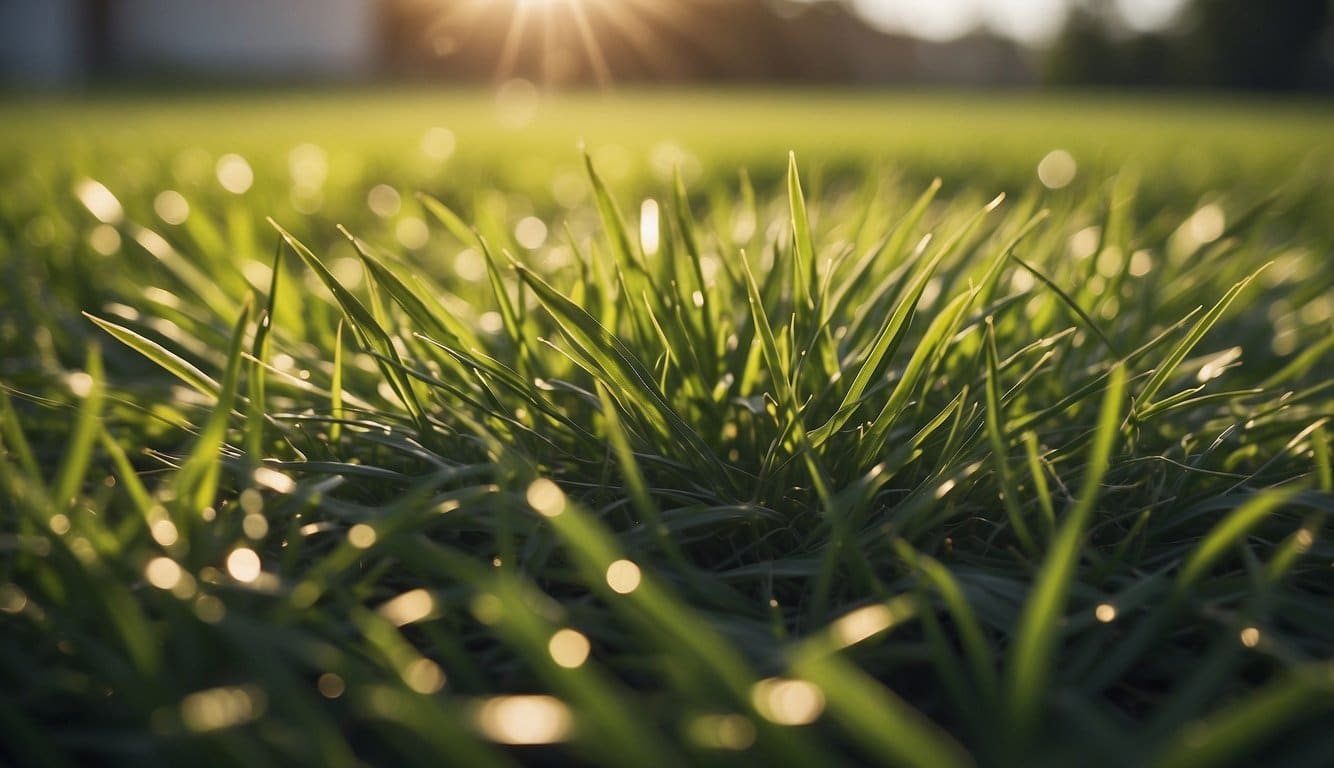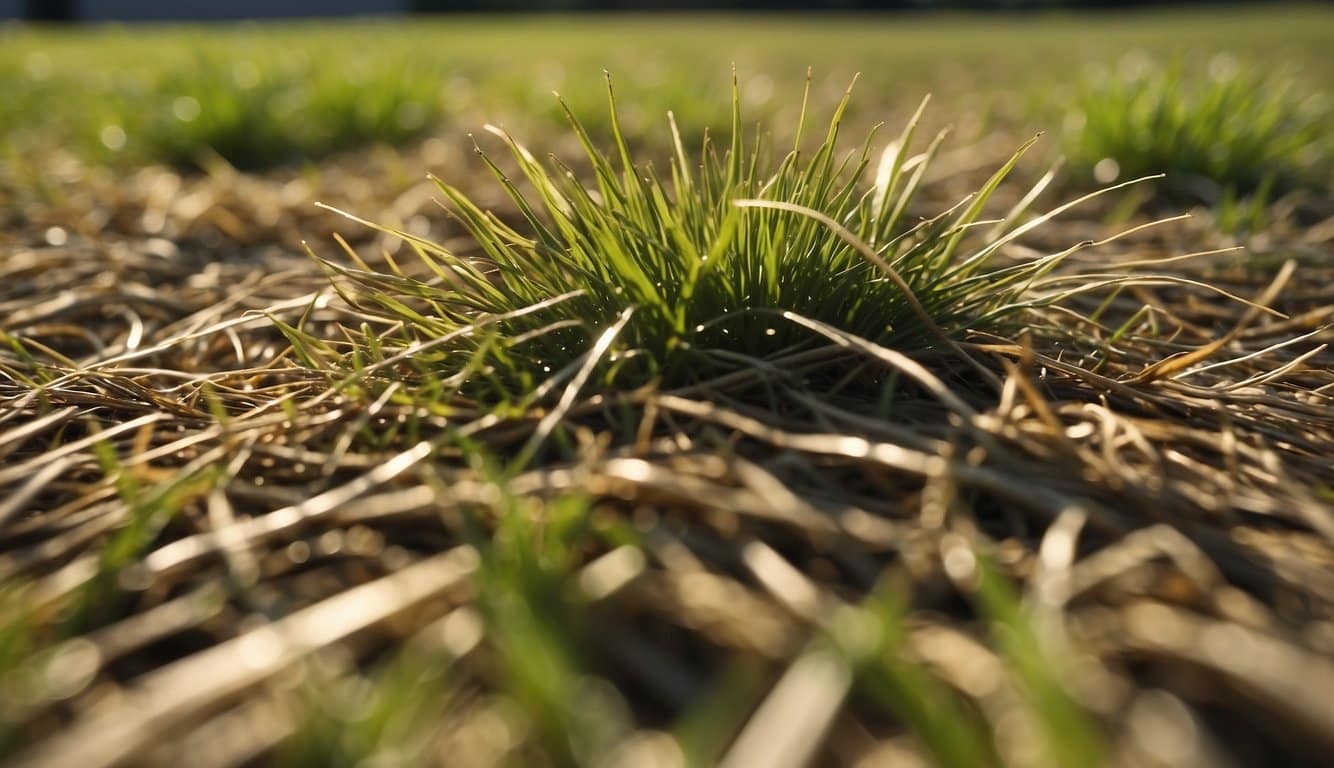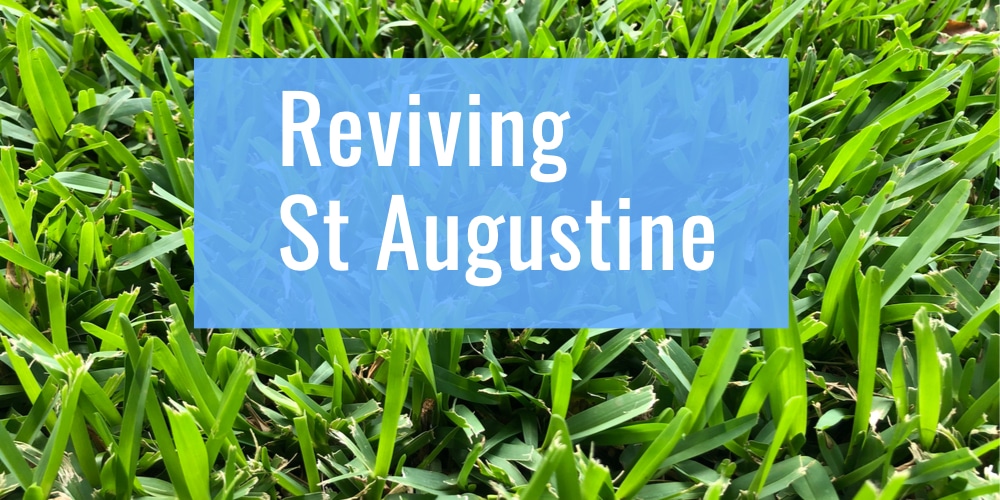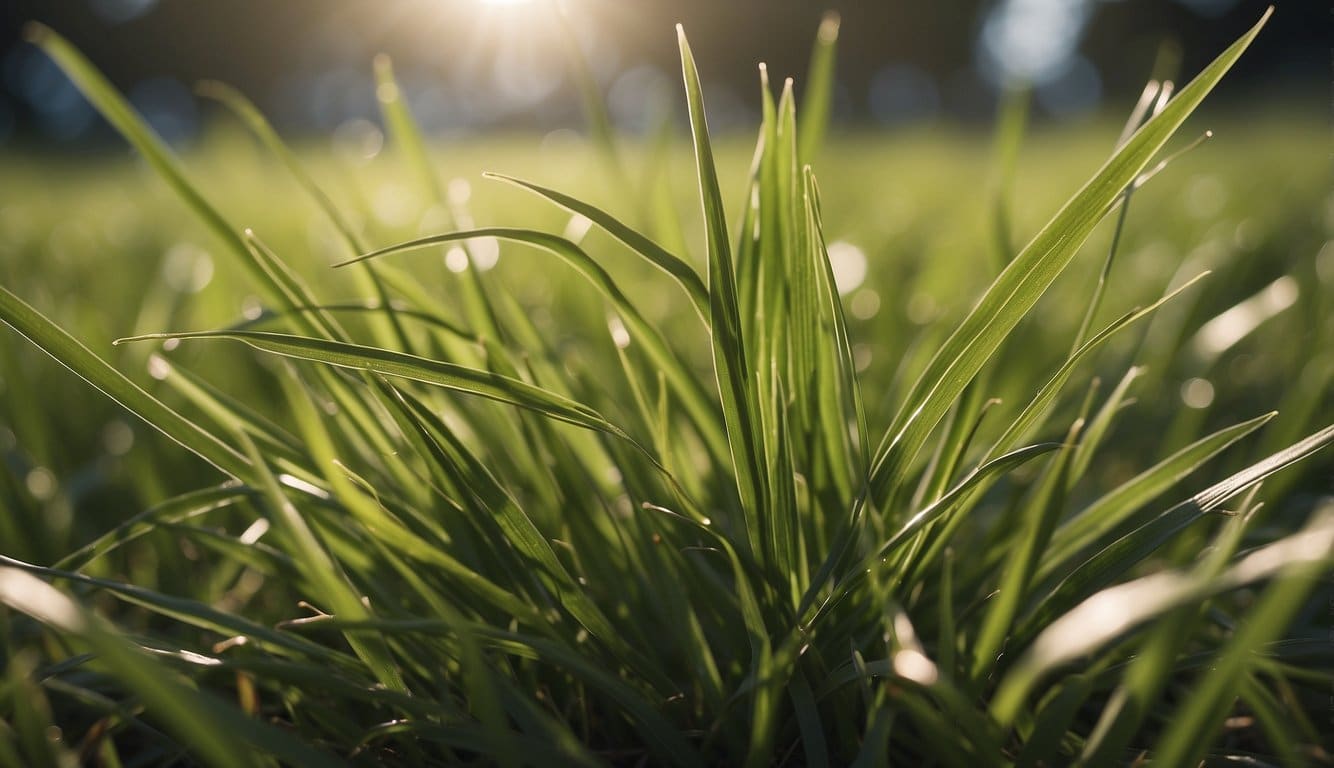St. Augustine grass, known for its robust nature and shade tolerance, is a preferred choice for lawns in warmer climates.
Despite its sturdiness, many homeowners encounter an issue where their lush lawn turns into a brittle, straw-like ground cover.
This transformation is not just a cosmetic issue but also a sign of underlying health problems affecting the turf.
The causes for St. Augustine grass to turn to straw are often associated with environmental stressors, such as improper watering practices, inadequate sunlight, or soil compaction, which can compromise the grass’s ability to absorb water and nutrients effectively.
Restoration of St. Augustine grass requires a balanced approach that entails correcting watering schedules, ensuring proper sun exposure, and mitigating any pest or disease issues.
In doing so, homeowners must be diligent in identifying the root cause of the problem to implement the appropriate solution.
Regular maintenance that includes aeration, pest control, and the right fertilization can prevent the issue from reoccurring.
By understanding the needs of St. Augustine grass and recognizing early signs of distress, a healthy, resilient lawn can be maintained throughout the year.
Quick Help and Restoration Table
| Cause | Symptoms | Solution |
|---|---|---|
| Drought Stress | Grass blades turn bluish-gray, soil is dry | Water deeply and less frequently to encourage deep root growth. Aim for 1 inch of water per week. |
| Excessive Heat | Grass becomes brittle, color fades | Water early in the morning to reduce evaporation. Consider shade cloth during peak heat. |
| Over-Fertilization | Grass turns yellow or brown, growth is stunted | Water heavily to flush out excess fertilizer. Wait for natural growth to resume before applying more. |
| Chinch Bugs | Irregular brown patches, grass pulls up easily | Apply insecticide specifically labeled for chinch bugs. Follow label directions for application rates and timing. |
| Grub Worms | Spongy turf, visible grubs under grass | Apply a grub control product in late spring or early summer. Follow the product’s instructions for application. |
| Fungal Diseases | Brown patches, thinning grass, fungal signs like mold | Apply a fungicide appropriate for the specific disease. Avoid watering in the evening to keep grass dry overnight. |
| Improper Mowing | Grass is scalped, weak growth | Adjust mower height. Cut no more than 1/3 of the grass blade at a time to avoid stress. |
New Seed
Causes of Straw-Like Appearance
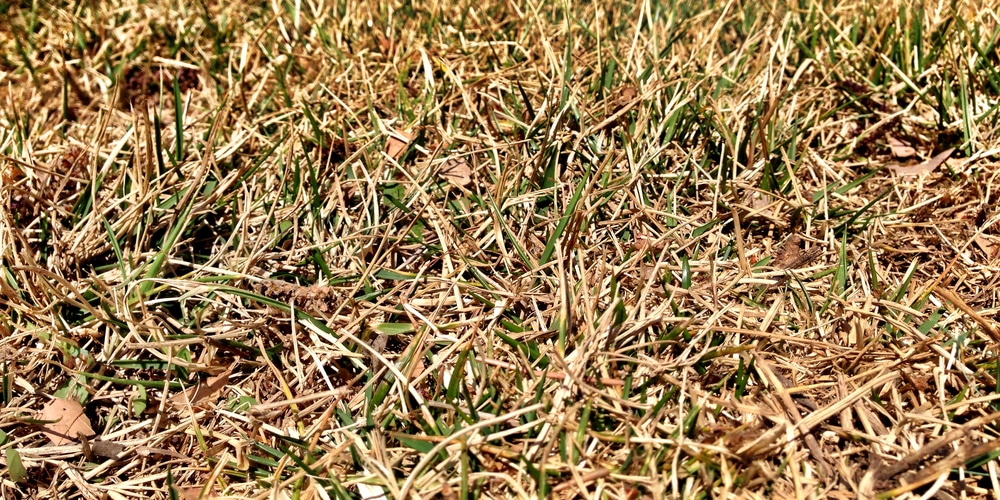
Turning straw-like in appearance is often indicative of underlying issues affecting St. Augustine grass. Recognizing these causes is the first step towards revitalization.
Drought Stress
When St. Augustine grass receives insufficient water, the blades can dry out and become brittle, resembling straw.
Symptoms of drought stress include:
- Grass blades folding in an attempt to conserve water
- A blue-gray tint to the grass before it turns brown
- Footprints that remain visible on the lawn for several minutes
Disease or Pest Infestation
Various diseases and pests can cause St. Augustine grass to appear straw-like. Key indicators include:
- Patchy areas of brown grass
- Visible signs of pests, such as chewed blades or the pests themselves
- Unusual spots or rings that indicate a fungal infection
- Chinch bugs: They suck plant juices and inject a toxin causing grass to turn yellow and then brown.
Improper Lawn Maintenance
Improper care can lead to a straw-like appearance in St. Augustine grass. Factors include:
- Over-watering: This suffocates roots, preventing oxygen and nutrient absorption, and can lead to root rot.
- Under-fertilization: Grass needs proper nutrients to stay healthy; a deficiency can weaken the grass and affect its color.
- Mowing too short: Cutting grass too low can stress it and make it vulnerable to pests and disease.
Restoration Strategies
In facing the challenge of reviving St. Augustine grass that has turned to straw, homeowners can adopt a multifaceted approach. This includes tailored watering practices, vigilant pest and disease management, and appropriate lawn renovation techniques.
Proper Watering Techniques
St. Augustine grass thrives when it receives 1 to 1.5 inches of water weekly.
To ensure even distribution, one might:
- Water once or twice a week, rather than daily.
- Utilize rain gauges to monitor the exact amount of water received.
- Water early in the morning to reduce evaporation.
Disease and Pest Management
A lawn’s health is compromised when pests or diseases take hold. One should:
- Apply a nitrogen-rich fertilizer to promote healthy growth.
- Use a grub control product if grubs are present, according to package directions.
- Check for signs of fungal diseases and apply an appropriate fungicide if necessary.
Lawn Renovation Practices
If parts of the lawn are beyond recovery, one may need to:
- Remove dead turf: Cut out dead areas to prepare for new sod or seed.
- Install new St. Augustine sod: Choose robust, disease-resistant varieties.
- Maintain a mowing height of about 3 inches to support root development and discourage weeds.
Preventative Measures
To maintain the vitality of St. Augustine grass and prevent it from turning to straw, one should focus on aspects of care such as fertilization, mowing, thatching, and managing diseases and pests.
Appropriate Fertilization
Proper fertilization is crucial in sustaining a healthy St. Augustine lawn.
Homeowners should conduct a soil test to determine the nutrient needs of their grass.
Nitrogen is particularly essential for lush growth, but over-fertilization must be avoided to prevent excessive thatch build-up and possible disease.
- Apply fertilizer with a balanced N-P-K ratio as indicated by soil test results.
- Ideally, fertilize St. Augustine grass every 2 months during the growing season, with a recommended rate of 4 pounds of nitrogen per 1,000 square feet per year.
Regular Mowing and Thatching
St. Augustine grass requires regular mowing to ensure it remains dense and able to outcompete weeds. However, cutting it too short can stress the grass, making it more susceptible to disease.
- Mow grass to a height of 2.5 to 4 inches, depending on shade and water availability.
- Dethatching should be done as needed when thatch exceeds 1/2 inch in depth.
Disease and Pest Prevention
Vigilant observation for signs of disease and pest infestation is essential. Fungus and insects can rapidly damage St. Augustine grass, leading to straw-like patches.
- Apply fungicides and insecticides only if there is evidence of disease or pests.
- Use proper watering techniques to prevent conditions that favor fungal growth.
Frequently Asked Questions
Maintaining the vibrant green of St. Augustine grass requires proper care and swift action when issues arise. This section addresses common concerns about why St. Augustine grass might appear straw-like and discolored and provides guidance on best practices for care and recovery.
Why does St. Augustine grass sometimes appear straw-like and discolored?
St. Augustine grass turns straw-like due to inadequate water supply, either from under-watering, which causes it to dry out, or over-watering, which suffocates and rots the roots, inhibiting oxygen and nutrient absorption.
How should St. Augustine grass be cared for in the winter to prevent it from turning straw-like?
In winter, they should minimize watering St. Augustine grass to counteract its dormant state and lower growth activity, as excessive moisture in cooler weather can increase disease susceptibility and cause the grass to take on a straw-like appearance.
What are the most effective ways to repair St. Augustine grass that has been damaged and looks like straw?
To repair damage, they need to accurately diagnose the cause—whether it’s pests, diseases, or environmental stress—and take appropriate actions, such as applying fungicides for fungal infections or adjusting watering practices for environmental factors.
Can St. Augustine grass recover from dormancy and regain its green color after looking straw-like?
St. Augustine grass can recover from dormancy and the straw-like coloration with proper spring care, which includes moderate watering, balanced fertilization, and disease and pest control as necessary.
What maintenance steps should be taken throughout the year to prevent St. Augustine grass from becoming straw-like?
Regular maintenance steps include proper irrigation, fertilization according to soil test recommendations, disease and pest monitoring, and mowing at the recommended height to maintain health and prevent straw-like conditions.
What are the best practices for fertilizing St. Augustine grass to maintain its health during cold months?
They should only apply fertilizers with potassium during the colder months.
This helps St. Augustine grass withstand cold stress.
Avoid nitrogen, which can promote new growth that is vulnerable to frost damage.
Last update on 2025-04-22 / Affiliate links / Images from Amazon Product Advertising API
